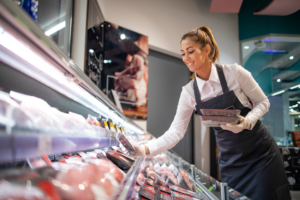Best Practices for Building Your Bridge to Supermarket Food Safety
Ensuring food safety has always been a top priority for retail food marketplaces, but starting in 2020, the demand to provide customers with food they know they can trust has become more critical than ever. Affinity Group is here with the in-depth knowledge you need to address modern retail complexities without compromising food safety and quality.

Tech to Table
During the pandemic, rapidly emerging e-fulfillment models combined with an entire population sheltering in place to create an unprecedented demand in the food retail marketplace. Seemingly overnight, retailers were faced with an influx of click-and-collect orders and home deliveries. This spike in demand introduced unexpected fulfillment challenges.
Acceleration of the E-Commerce Explosion at a Glance
- More than 50% of today’s shoppers purchase their groceries online and 20% made their first online grocery purchase because of COVID-19
- Consumers ordering food online nearly quadrupled from 11% to 41% between March 1 and March 22, 2020.
- Click-and-collect accounted for nearly 77% of food & beverage online purchases during lockdowns
- 67% of click-and-collect customers plan to continue using the service post-pandemic.
Safety Still Comes First
From harvest to production to storage and delivery, safely providing food to your customers still requires both the ability to maintain proper temperature ranges as well as following proper sanitation and hygiene. The emergence of the challenges brought on by the pandemic only further heightened the importance of maintaining food safety at every point on your food’s journey to your customers.
Food Safety Impacts in America
- Every year, 1 in 6 Americans contract foodborne illnesses and nearly 3,000 die.
The High Cost of Foodborne Illness Outbreaks
- A retailer could incur costs between $4,000 and $2.5 million for a single outbreak.
Ensuring Food Safety from Farm to Fork
Providing consistently safe and high-quality food in the supermarket is a responsibility every stakeholder in the supply chain must share. To ensure food safety and quality, an unbroken chain of temperature certainty and safe handling practices is required. Common factors that impact the supermarket food supply chain include:
- Spread of bacterial pathogens that can cause food poisoning, such as E. coli and listeria
- Cross-contamination
- Poor employee hygiene
- Unsafe or unsanitary processing or food preparation methods
Keep Your Produce at the Proper Temp
Produce and perishable commodities must be kept within optimal temperatures to prevent the growth of bacteria, maximize freshness, increase shelf life, and avoid food waste. Cook-and-hold procedures also must maintain food at optimal holding temperatures, and this requires frequent checking and documentation of internal food temperatures to ensure food quality and safety.

Fresher Possibilities
Online order fulfillment presents new challenges for maintaining optimal temperature control. Chilled perishables and frozen goods must be kept within optimal temperature ranges.
The clock starts ticking on fresh produce pretty much the moment it gets picked, so prioritizing processes that can help stunt decay and prolong freshness are hugely beneficial to both food safety and fulfilling e-commerce demands.
- Flash cooling/freezing
- Temporary staging in a storage cooler prior to shipping
- Pre-cooled containers, which help remove excess field heat
At a time when grocery retailers are being held to increasingly higher and higher food safety and quality standards, you can always count on Affinity Group. Our highly trained retail food specialists are experts in the operational challenges of today. We’re always ready to help you explore the endless possibilities of your brand as you continue building your Bridge to Success.